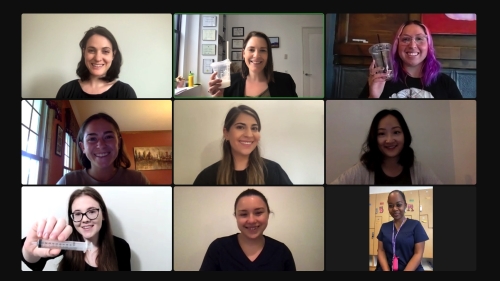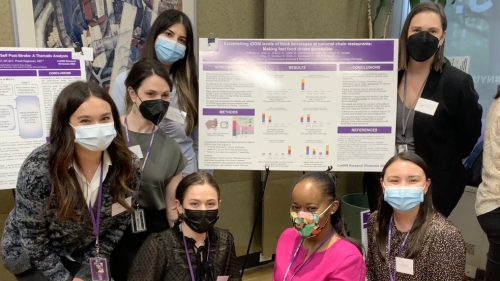NYU Steinhardt students conducted virtual research to safely categorize commercially available drinks for patients with swallowing difficulties.

(L to R, top to bottom) Celia Smith, Sonja Molfenter, Cyn Perez, Kelly Veit, Chantal Zepeda, Eva Chan, Sarah Sokolowski, Mei Ling Leon and Khamiya Nisbett (not pictured Natalie Guerrisi, Elizabeth LaBossiere, Marian Isdahl, Regina Magid and Maylani Quizhpe)
NYU Steinhardt students in the Communicative Sciences and Disorders (CSD) department are working together – and virtually – to help people with swallowing disorders (or dysphagia) safely consume drinks from national restaurants chains.
Sonja Molfenter, PhD CCC-SLP, associate professor in CSD and co-director of the Center of Health and Rehabilitation Research (CoHRR), initiated the project during the pandemic as a way to keep students engaged in hands-on research.
“Because everything was suspended, I felt for my students that they couldn’t have a research experience,” says Molfenter, whose research specializes in understanding the physiological features of both normal swallowing and disordered swallowing. “I started brainstorming what we could work on collaboratively from wherever we were, and this idea around the IDDSI classifications seemed like a great option.”
IDDSI – or the International Dysphagia Diet Standardization Initiative – seeks to create a universal, international way in which to describe texture modified foods and thickened liquids. This standardization is critical for the safety of patients who could be at risk for aspirating an unsuitably thick or thin food or liquid.
“IDDSI’s global nomenclature is important because it ensures consistency between what speech pathologists prescribe for patients and what foods dieticians can suggest for their health and hydration,” says Molfenter.
Designing a Virtual Research Project
Molfenter’s idea for her students focused on measuring the consistency of blended drinks found at nationwide restaurants such as Starbucks, Panera, and McDonald’s to help caregivers and patients find commercially available liquids that they could safely consume.
Demonstration of an IDDSI flow test.
The IDDSI testing methodology uses a 10 mL syringe (like a larger version of those that come with baby Tylenol) and a timer to categorize the liquids’ viscosity according to their framework.
“Once we selected our restaurants, the students did research into their menus and selected a few beverages from each,” says Molfenter, who taught students how to perform the test and sent them testing kits for consistency. “Students tested drinks at timed intervals to look at stability, as well as made repeat visits to the same store location to retest drinks for reliability.”
First-year master’s student Cyn Perez ’23 became involved in Molfenter’s research during her very first semester, necessitating some upfront research on dysphagia and IDDSI before diving in.
“It was such an interesting project, and collecting the data was a lot of fun,” says Perez. “I want to do lots more medical research because that’s where I’m interested in going with my career, but I also really enjoyed the empathetic side of this project and the idea of helping others.”
Students completed their tests in different states, temperatures, and times to find the most consistent drinks, from McDonald’s milkshakes to Starbucks frappuccinos. Once compiled, the data can be shared with patients to allow them to make safe beverage choices from the parameters given by their doctors and pathologists.
“We had a master spreadsheet where everyone entered their findings, and then we established trends,” says Marian Isdahl ’22, a CSD master’s student who took a lead role with the data analysis. “McDonald’s was astonishingly consistent over time, and we found that drinks with blended ice from Starbucks were more volatile because the melting ice changed the consistency quickly.”
Like Molfenter, Isdahl is passionate about dysphagia and the way it combines the medical side of the field with compassion. After graduating, she has accepted a clinical fellowship at the University of Wisconsin-Madison specializing in adult swallowing, during which she will conduct research and work in acute care in the hospital with dysphagia patients.

Presenting project findings at the CoHRR Spring Showcase (L to R: Natalie Guerrisi, Celia Smith, Chantal Zepeda, Kelly Veit, Khamiya Nisbett, Mei Ling Leon, Sonja Molfenter)
Last month a selection of the students presented the groups’ findings at the NYU Steinhardt CoHRR Spring Research showcase. Molfenter has also submitted the students’ work to the American Speech-Language-Hearing Association (ASHA) in the hopes of securing a conference presentation – an important resume-builder for students. They also hope to get this kind of data in front of patients and caregivers to increase quality of life – especially timely as June is Dysphagia Awareness Month.
“With this work, we wanted to do the legwork that allows patients and caregivers the opportunity to safely be more creative with what they eat and drink,” says Molfenter. “The IDDSI classifications are a gamechanger for people with dysphagia, and we’d love to see this system gain more traction.”

